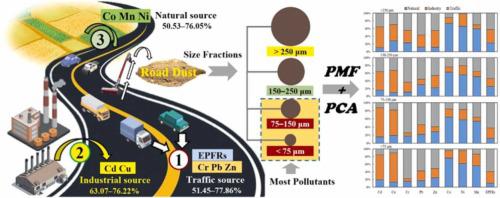Process Safety and Environmental Protection ( IF 6.9 ) Pub Date : 2021-11-25 , DOI: 10.1016/j.psep.2021.11.039 Wenli Feng 1, 2 , Yongfang Zhang 1 , Liangliang Huang 3 , Yunlin Li 1, 2 , Shuge Wang 1 , Yi Zheng 1 , Lei Shi 4 , Ke Xu 5

|
The partitioning of pollutants in the size-fractions of road dust particles is extremely important to their migration and bioavailability in the air environment. Herein, the pollution characteristics and sources of heavy metals (As, Cd, Cu, Cr, Pb, Zn, Co, Mn, Ni) and environmentally persistent free radicals (EPFRs) are investigated in 64 samples of mixed particle-size road dust in four size fractions (>250 µm, 150–250 µm, 75–150 µm,<75 µm). The samples were collected from urban arterial roads of three cities in the core of Central Plains Urban Agglomeration. The results indicate that 67.70% of the road dust (by mass) consist of the<75 µm particles size fraction, and that the highest levels of EPFRs and heavy metals are concentrated in the<150 µm and< 75 µm size fractions. In addition, Cd exhibits extremely high average enrichment factors (EFs) of 51.84 in the 75–150 µm fraction and 64.80 and<75 µm fraction. Further analysis reveals a remarkable correlation between EPFR concentration and the concentrations Zn and Cr in the road dust. An application of principal component analysis (PCA) and positive matrix factorization (PMF) to the regional investigation and the layout of functional zones demonstrates that Cr, Pb, Zn and EPFRs are mainly derived from traffic emissions, and account for 51.45–77.86% of the fine particle fraction (<150 µm). Meanwhile, industrial activities are identified as the primary source of Cd and Cu, accounting for 63.07–76.22% of the<150 µm particle size fraction. These findings suggest a potential risk of EPFRs and heavy metals in fine particulate matter, and provide a new insight into the potential sources and health risks of EPFRs in road dust. Therefore, further studies are needed in order to explore the EPFRs in fine particulate particles and to assess their effects upon human health.
中文翻译:

环境持久性自由基 (EPFRs) 和重金属在城市主干道路灰尘大小部分的来源分配
污染物在道路灰尘颗粒的大小部分中的分配对其在空气环境中的迁移和生物利用度极为重要。在此,研究了 64 份混合粒径道路扬尘样品中重金属(As、Cd、Cu、Cr、Pb、Zn、Co、Mn、Ni)和环境持久性自由基(EPFRs)的污染特征和来源。四种粒度级分(>250 µm、150–250 µm、75–150 µm、<75 µm)。样本采集于中原城市群核心区三个城市的城市主干道。结果表明,67.70% 的道路灰尘(按质量计)由小于 75 µm 的粒径部分组成,并且最高水平的 EPFR 和重金属集中在小于 150 µm 和 < 75 µm 的粒径部分。此外,Cd 在 75–150 µm 级分和 64.80 和 <75 µm 级分中表现出极高的平均富集因子 (EF),为 51.84。进一步的分析揭示了 EPFR 浓度与道路灰尘中 Zn 和 Cr 浓度之间的显着相关性。将主成分分析(PCA)和正矩阵分解(PMF)应用于区域调查和功能区布局表明,Cr、Pb、Zn和EPFRs主要来源于交通排放,占总排放量的51.45-77.86%。细颗粒部分 (<150 µm)。同时,工业活动被确定为 Cd 和 Cu 的主要来源,占<150 µm 粒径部分的 63.07–76.22%。这些发现表明细颗粒物中存在 EPFR 和重金属的潜在风险,并提供对道路灰尘中 EPFR 的潜在来源和健康风险的新见解。因此,需要进一步研究以探索细颗粒中的 EPFR 并评估它们对人类健康的影响。











































 京公网安备 11010802027423号
京公网安备 11010802027423号